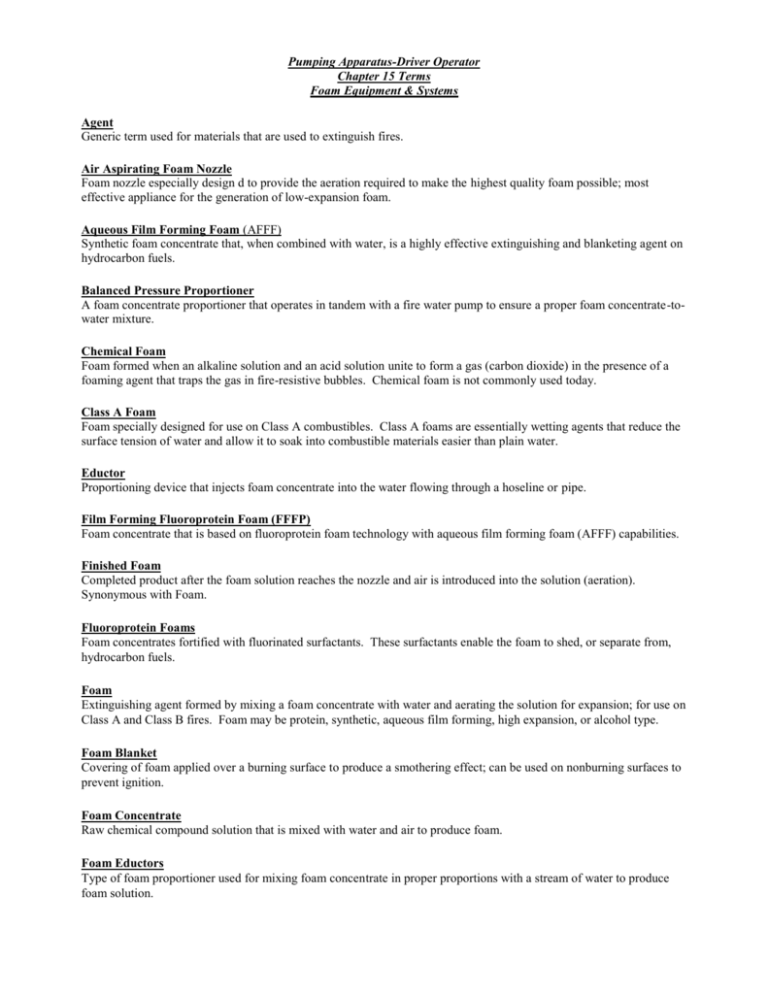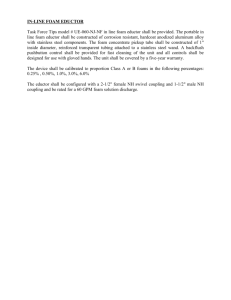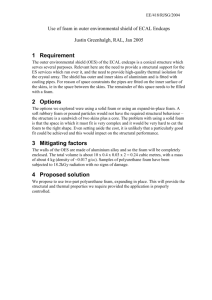Pumping Apparatus Driver Operator (1st Edition
advertisement

Pumping Apparatus-Driver Operator Chapter 15 Terms Foam Equipment & Systems Agent Generic term used for materials that are used to extinguish fires. Air Aspirating Foam Nozzle Foam nozzle especially design d to provide the aeration required to make the highest quality foam possible; most effective appliance for the generation of low-expansion foam. Aqueous Film Forming Foam (AFFF) Synthetic foam concentrate that, when combined with water, is a highly effective extinguishing and blanketing agent on hydrocarbon fuels. Balanced Pressure Proportioner A foam concentrate proportioner that operates in tandem with a fire water pump to ensure a proper foam concentrate-towater mixture. Chemical Foam Foam formed when an alkaline solution and an acid solution unite to form a gas (carbon dioxide) in the presence of a foaming agent that traps the gas in fire-resistive bubbles. Chemical foam is not commonly used today. Class A Foam Foam specially designed for use on Class A combustibles. Class A foams are essentially wetting agents that reduce the surface tension of water and allow it to soak into combustible materials easier than plain water. Eductor Proportioning device that injects foam concentrate into the water flowing through a hoseline or pipe. Film Forming Fluoroprotein Foam (FFFP) Foam concentrate that is based on fluoroprotein foam technology with aqueous film forming foam (AFFF) capabilities. Finished Foam Completed product after the foam solution reaches the nozzle and air is introduced into the solution (aeration). Synonymous with Foam. Fluoroprotein Foams Foam concentrates fortified with fluorinated surfactants. These surfactants enable the foam to shed, or separate from, hydrocarbon fuels. Foam Extinguishing agent formed by mixing a foam concentrate with water and aerating the solution for expansion; for use on Class A and Class B fires. Foam may be protein, synthetic, aqueous film forming, high expansion, or alcohol type. Foam Blanket Covering of foam applied over a burning surface to produce a smothering effect; can be used on nonburning surfaces to prevent ignition. Foam Concentrate Raw chemical compound solution that is mixed with water and air to produce foam. Foam Eductors Type of foam proportioner used for mixing foam concentrate in proper proportions with a stream of water to produce foam solution. Foam Proportioner Device that injects the correct amount of foam concentrate into the water stream to make the foam solution. Foam Solution Mixture of foam concentrate and water after it leaves the proportioner but before it is discharged from the nozzle and air is added to it. Inline Eductor Eductor that is placed along the length of a hoseline. Mechanical Foam Foam that requires the blending of water, foam concentrate, and air to be developed. Proportioner Device used to introduce the correct amount of foam concentrate into a stream of water. Proportioning Valve Valve used to balance or divide the air supply between the aeration system and the discharge manifold of a foam system. Protein Foam Protein foams are chemically broken down (hydrolyzed) protein solids. The end product of this chemical digestion is protein liquid concentrate. Venturi Principle When a fluid is forced under pressure through a restricted orifice, there is a decrease in the pressure exerted against the side of the constriction and a corresponding increase in the velocity of the fluid. Because the surrounding air is under greater pressure, it rushes into the area of lower pressure. Wet Water Wetting agent that is introduced to water to reduce the surface tension and improve its penetration qualities. Wetting Agent Chemical solution added to water to reduce its surface tension and improve its penetrating ability; detergent is a mild form of wetting agent.






